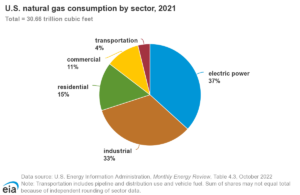Recent news headlines are screaming that the feds are coming for your gas stove. That’s more than a bit of hyperbole. What is true is that the use of a gas stove can have a negative impact on the inside air of a home or restaurant if not ventilated properly. That is because methane (natural gas) is a greenhouse gas.
Natural gas and propane stoves can release carbon monoxide, formaldehyde, and other harmful pollutants into the air, which can be toxic to people and pets.
Long-term droughts, atmospheric rivers and warming oceans are a few signs of climate change. All good reasons to think of practical ways to limit the damage we continue to do to our environment. The way we build, heat and cool our homes can have a big impact on climate change. In the following graph, it is plain to see that the amount of natural gas used to produce electric power and the commercial and industrial uses of natural gas far outweigh residential uses.

So, while the way we cook our food is also a factor, it pales by comparison to other uses. Listening to the debate you wouldn’t know that, since the political divide is ginning up arguments on both sides. A recent opinion piece in the Washington Post hammered both the Dems and the GOP for missing the point. A quick look at the state-by-state breakdown of who is cooking with gas shows that the majority of US households cook on electric stoves. Interestingly enough, California, Nevada, Illinois, New York and New Jersey are the biggest users of gas stoves. It reveals a little bit of a red state/blue state thing.
 The opinion writer argued that while gas stoves do cause indoor air pollution, running the vent fan or opening a window can alleviate that. The bigger question is the continued use of fossil fuels overall.
The opinion writer argued that while gas stoves do cause indoor air pollution, running the vent fan or opening a window can alleviate that. The bigger question is the continued use of fossil fuels overall.
Limiting the use of natural gas
While the federal government is not actually implementing a ban on gas stoves, as we noted in an earlier post, many local municipalities have already waded into the debate. Bans on new gas hookups for new construction are already in place in many communities in Marin and other Bay Area counties. It can prove to be a touchy subject for those who love cooking with gas.
You don’t need to worry that the government is coming for your gas stove, but here are some tips to from the California Air Resources Board to improve the air quality in your kitchen.
Studies show that air can be unhealthy to breathe when people cook in kitchens with poor ventilation. The best way to ventilate your kitchen is to use a properly installed, high efficiency range hood over your stove. A high efficiency range hood has a high cubic feet per minute (cfm) rating and a low sones (noise) rating. If you have a gas stove, a qualified technician should inspect it every year for gas leaks and carbon monoxide.
Ways to improve ventilation in your kitchen
If you have a range hood:
- Check to make sure it vents to the outdoors.
- Use it while cooking or using your stove
- Cook on the back burners, if possible, because the range hood exhausts this area more effectively.
If you don’t have a range hood:
- Use a wall or ceiling exhaust fan while cooking.
- Open windows and/or exterior doors to improve air flow through the kitchen.
If you are considering a kitchen project you’d like to discuss, we’d love to explore your options.


